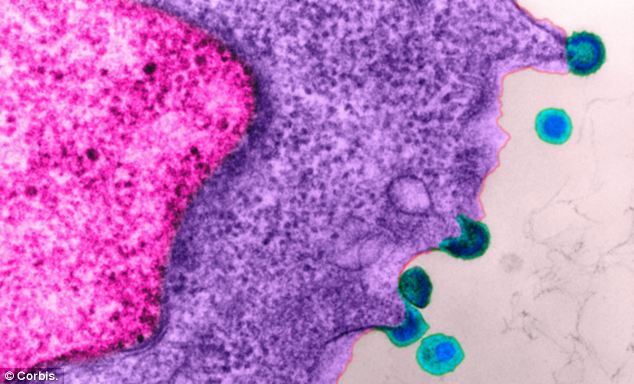New and more virulent strain of HIV is spreading rapidly through Russia, claim scientists
- The HIV subtype 02_AG/A is spreading rapidly and is now thought to account for more than 50 per cent of new HIV infections in Siberia
- It is thought to be the most virulent subtype of the virus in Russia
- Infections have also been reported in Chechnya, Kyrgyzstan and Kazakhstan

Russian scientists believe they have identified a new and more virulent strain of HIV. The subtype, known as 02_AG/A, is spreading rapidly. Image shows mature HIV virus infection.
It was discovered by scientists at the State Research Center of Virology and Biotechnology VECTOR in Siberia, The Moscow News reports.
Natalya Gashnikova, head of the retroviruses department at Vektor, said 02_AG/A could spread through the population much more quickly than the current main HIV strain found in Russia.
The number of HIV positive people in Novosibirsk has jumped from 2,000 in 2007 to 15,000 in 2012, according to Russia’s Federal AIDS Centre and 50 per cent of the new cases have been caused by 02_AG/A.
The newly identified subtype is not confined to Siberia – cases have also been reported in Chechnya, in the south of Russia, and Kyrgyzstan and Kazakhstan.
HIV can be divided into two main types – HIV-1 and HIV-2. HIV-1 is the more virulent of the two and is, therefore, responsible for the majority of cases.
HIV-1 can also be divided into subgroups and the newly discovered 02_AG/A is a subgroup of HIV-1.
All of the subgroups are transmitted from person to person through the same transmission methods – including unprotected sex and sharing needles – but some are easier to pass on than others.
02_AG/A is thought to be easier to transmit than some other subtypes.

The virus was first seen in the city of Novosibirsk in 2006 and is thought to be the most virulent subtype of the virus in Russia. It is now thought to account for more than 50 per cent of new HIV infections in Siberia.
UN figures show that the only regions where the number of HIV infections is increasing are Eastern Europe and Central Asia – 52 per cent of people with HIV in this area live in Russia.
This is believed to be partly because there is little awareness of HIV in many parts of Russia and because Russian school offer very little sex education.
The number of new HIV infections globally has plummeted by a third since 2001 and more than halved among children, the United Nations recently revealed.
Globally, 2.3 million people contracted the AIDS virus last year – down 33 per cent from 2001, while 260,000 children became infected – 52 per cent less than in 2001.
‘The annual number of new HIV infections continues to decline with especially sharp reductions in the number of children newly infected with HIV,’ UNAIDS executive director Michel Sidibe said.
Last year, 1.6 million people died of AIDS-related deaths, down from 1.8 million in 2011 and 2.3 million in 2005.
The report showed that 9.7 million people in low and middle-income countries, the bulk of those infected, had access to HIV drugs last year, compared to only 1.3 million seven years earlier.
While the hike is impressive, it falls short of a UN target announced two years ago to reach 15 million people by 2015.
Some 35.3 million people were living with the virus last year – about 70 per cent of them in sub-Saharan Africa – up from 30 million in 2001.
Source: Daily Mail
